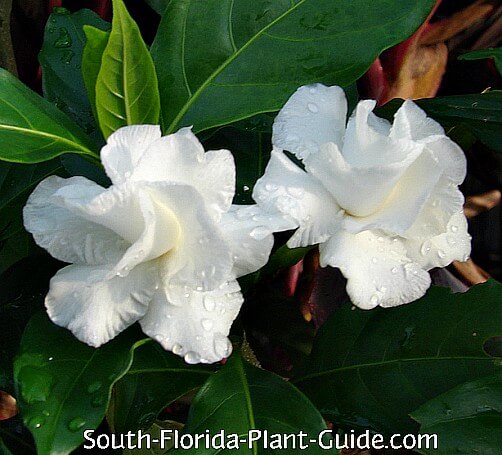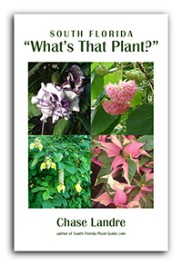Crape Jasmine Tree
Tabernaemontana divaricata
The crape jasmine tree - with its pretty form and exquisite, sweetly-scented flowers - makes a wonderful accent anywhere in the landscape...even in part shade.

Sometimes spelled "crepe jasmine" - or called "cape jasmine" - these are actually shrubs that can be used as hedges or specimen plants in bush form, but as a small ornamental tree of 8 feet or less they're at their best.
You can start with a shrub and as it grows a tall, wide crown, the base can be kept cleaned up to look more tree-like.
Or you can shop your local nurseries to buy one trained to a single trunk.
With its ruffled-edge, white double flowers, this plant creates a big show of blossoms in spring and then blooms on and off through summer.
Their fragrance is stronger by evening, making this a desirable small tree near a patio, screened lanai or pool cage.
Similar in looks (though the fragrance is different) to gardenias, crapes can be somewhat easier care - more cold-tolerant and less prone to insect invasions.
Plant specs
This plant is a moderate grower for full to part sun, though it actually prefers partial shade and will flower there. Its ultimate height is about 8 feet tall with a 6 foot wide top.
Evergreen with large, shiny, deep green leaves, this jasmine (though not a "true" jasmine - at one time everything with a sweet-smelling flower was called jasmine) is moderately cold hardy, doing best in Zone 10A and warmer areas of Zone 9B.
Give it a spot sheltered from winter winds. Though a colder winter may defoliate the plant, it should flush back out in spring.
Plant care
Plant with either top soil or organic peat moss in combination with composted cow manure as soil amendments.
The crape jasmine tree needs regular waterings. Trim occasionally to shape.
Fertilize in spring, summer and autumn with a good quality fertilizer high in phosphorus (or supplement with bone meal or liquid) to promote maximum bloom.
Plant spacing
A jasmine tree can be placed close to the house - as near as 3 or 4 feet away. If you're planting a row or grouping, place them 3 to 5 feet apart.
Crapes will grow in large containers as long as watering is regular and sufficient.
Landscape uses for the crape jasmine tree
- understory planting amid tall palms and trees
- backdrop plant for smaller shrubs and flowers
- focal point near the entry
- accent tree for the corner of the house or to highlight any architectural element
- shade or privacy for patio or pool areas
- lining a walkway or fence
- to add height and interest to blank walls
- near a birdbath and/or feeder to provide shelter
- in pairs flanking a gate
- anchor plant for a garden bed
A.K.A (also known as): Cape Jasmine, Crepe Jasmine
GOOD SNOWBIRD PLANT? MAYBE (in warmer areas of South Florida and with regular irrigation)
COMPANION PLANT SUGGESTIONS: For a partial shade area, try pentas, Aztec grass, variegated arboricola, caladiums, crotons, golden shrimp plant, foxtail fern, dwarf oyster plant, and variegated peperomia.
Other flowering trees you might like: Hibiscus Tree, Powderpuff Tree
Take a break!
The ultimate guide to low-maintenance plants
and landscaping!
An ebook by
Chase Landre
author of
South-Florida-Plant-Guide.com
Learn more!
Get a greener thumb!
Want to learn more about South Florida planting, watering, fertilizing and dealing with weeds and pests?
See our Gardening How-To section for answers!
Get instant curb appeal!
An ebook by
Chase Landre
author of
South-Florida-Plant-Guide.com
Learn how to get instant curb appeal with fast growing plants and landscaping techniques!



